Contact MeUse the contact form at the bottom on almost all the pages on this site or let's have a Other ways to Support My WorkSubscribe to Insight-Live.com. It is about doing testing and development, not letting information slip away. Help Me on Social
Login to your online account Chemistry plus physics. Maintain your recipes, test results, firing schedules, pictures, materials, projects, etc. Access your data from any connected device. Import desktop Insight data (and of other products). Group accounts for industry and education. Private accounts for potters. Get started. Download for Mac, PC, Linux Interactive glaze chemistry for the desktop. Free (no longer in development but still maintained, M1 Mac version now available). Download here or in the Files panel within your Insight-live.com account. What people have said about Digitalfire
What people have said about Insight-Live
| Monthly Tech-Tip from Tony HansenI will send practical posts like these (from thousands I maintain). No ads or tracking. We are troubleshooting the confirm email, for now you will be subscribed immediately (the first monthly email will provide one-click unsubscribe). BlogGlaze cracking during drying? Wash it off and then do this.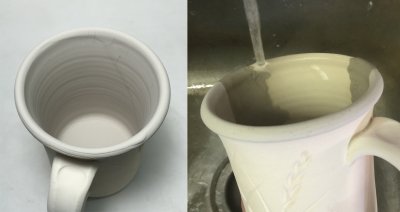
If your pottery glaze is doing on drying then it will crawl during firing. Wash it off, dry the ware. Then check the water content. If the glaze has worked fine in the past then it is likely going on too thick because the specific gravity is too high - just repeat cycles of adding a little water and dip testing (make it thixotropic if needed). But that was not the issue here. Glazes need clay to suspend and harden them, but too much clay means trouble. This was Ravenscrag Slip, a clay, being used pure as a cone 10R glaze. The glaze appeared to go in perfectly and it dried to the touch in ~20 seconds. But shrinkage continues after that, revealing after a couple of minutes. Fixing the issue was a matter of adding some roasted Ravencrag Slip to the bucket. That reduced the shrinkage and therefore the cracking. Any glaze containing excessive kaolin can be fixed the same way (trade some of the raw kaolin for calcined kaolin). Some glazes that contain plenty of clay also have bentonite - a simple fix for these is to simply remove the bentonite. Context: Calcined Kaolin, Calcination, Crawling Friday 5th December 2025 Custer Feldspar vs Nepheline Syenite at cone 8 oxidation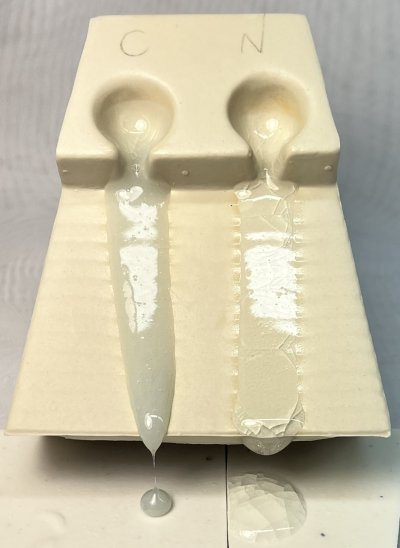
Although Nepheline Syenite and Custer Feldspar are used as effective body maturing agents and fluxes in glazes past cone 6, curiously, neither of them melt well by themselves. Thus, both of these come 6 melt fluidity tests add 20% Ferro Frit 3134 to get them flowing. This is a 2021 shipment of the feldspar and a 2022 shipment of the nepheline. Context: Custer Feldspar, Nepheline Syenite, Casting pure nepheline syenite.., Pure nepheline syenite mug.. Thursday 27th November 2025 Low fire ware cracking during firing. Why?
Most low-fire bodies contain talc. It is added for the express purpose of increasing thermal expansion. The natural quartz particles present do the same. These are good for glaze fit but bad for ware like this. There are also sudden volume changes associated with cristobalite, but it forms (from quartz) at stoneware temperatures so should not be a concern in terra cotta or a white low fire body. You could fiddle with the clay recipe or change bodies, but better to change the firing schedule. The quartz in stonewares goes through a sudden volume change between 950-1150F on the way down. Quartz particles in low fire bodies will do the same. A simple fix is to slow down the entire cooling cycle like this potter did. Or, learn to program your kiln to approach this range more slowly, then ease down through it. No electronic controller? Learn a switch-setting-schedule to approximate this down-ramp (buy a pyrometer if needed). Context: Manually programming a Bartlett.., Dunting, Quartz Inversion, Cristobalite Inversion, Cristobalite Sunday 23rd November 2025 Non-plastic clay is required hereNo potter could use it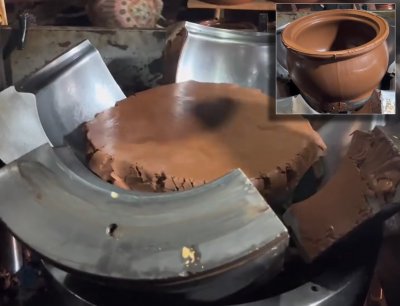
Potters love plastic clay. On the wheel it enables pulling larger, more overhang, thinner walled pieces. For beginners it can make the difference between success or a collapsed lump of mud. The downside is high drying shrinkage and danger of cracking. But potters know how to exercise care in drying to get success anyway. Context: Video on Instragram shows.. Saturday 22nd November 2025 Thrown pieces made from pure Grolleg and EP kaolinsThis is how you compare plasticities
These have just been thrown on the wheel. I find it to be a foolproof method of comparing the plasticity of two clays. They were slurried up and dewatered to about the same moisture content and the same amount was thrown to compare the size achievable. While the Grolleg is stickier and dewaters a little slower, it is not nearly as plastic as EPK (which itself is not that plastic compared to others). Curiously, New Zealand kaolin (halloysite) is quite a bit less plastic than the Grolleg but it responds to plasticity augmentation (in porcelain recipes) just as well as Grolleg (similar amounts of bentonite producing similar plasticities). And, bodies containing EPK also need about the same amount of bentonite to produce plasticity suitable for throwing large forms. So, the plasticity that a kaolin appears to have by itself is not completely indicative of what it will contribute to a body (if augmented with bentonite). The EPK used here is the darker and more plastic of the two varieties we receive. Context: EP Kaolin, EPK fired bar top.. Wednesday 19th November 2025 The ultimate example of delayed crazing: 90 years!Glaze chemistry is the key to understanding it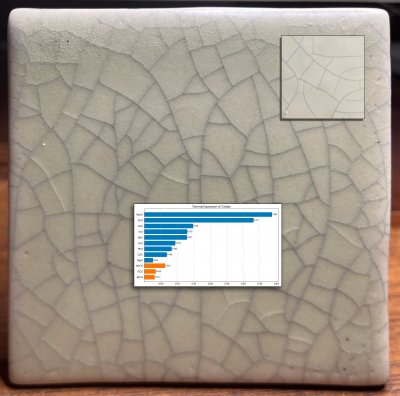
A restoration project faced a tile-matching challenge. At installation in a bathroom 90 years ago, the tiles were not crazed. But between then and now it happened (shown inset upper right). Now, a restoration specialist is tasked with duplicating the aged effect (one unsuccessful attempt is shown here). The shade, opacity, degree of matteness, bubble-free matrix and surface character of the original are all real challenges. Duplicating the crazing is even more difficult. Why? Matching "time-crazing" with a crackle glaze pattern will be temporary (it will craze much more after installation). Context: Turning delayed crazing into.., Glaze Crazing Monday 10th November 2025 Potter goes full DIY and makes her own porcelainThe best thing happens: Failure on the third mix!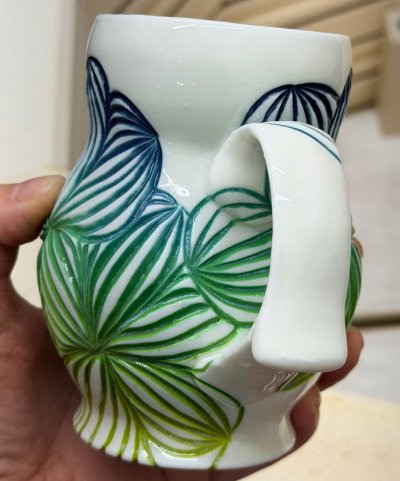
Super white translucent porcelains are expensive, approaching $200/box in some countries! Even so, variation in properties is common (certainly not good for a "tipping point body" that is difficult to make). The idea of making your own clay body is actually feasible here. Yet Kirsty Kash, maker of this mug, told me that this amount of DIY was something she had never really considered, thinking it would be too complicated without guidance. But ongoing issues with the commercial clay gave her the motivation to give it a try (using a recipe similar to L3778D). She weighed out the materials, slurried up the mix using a propeller mixer, finished by blender mixing and then dewatered on a super-clean plaster bat. Context: Formulating a Porcelain, Agglomeration of New Zealand.., Kirsty Kash Ceramics, Digitalfire Insight-Live Saturday 8th November 2025 A grog addition makes thermal shock resistance worse?I tested this in a low COE Pyrax:Kaolin bodyPyrax (Pyrophillite) is a mineral having a very low thermal expansion. It stands to reason that if we can maximize its percentage in a body and not fire the body to a point that changes the crystal structure, it will be resistant to thermal-shock cracking. To that end, I mixed it with only kaolin (ball clay would add some quartz that would increase thermal expansion). I made slip-cast pieces of similar thickness for testing. I fired them to cone 2 (after finding that by cone 4, shock-resistance begins to decline). As you can see from the video, the addition of grog actually harms the performance! The higher the Pyrax, the better. To get a real appreciation for how well this body endures differential heat stress, wait till the end to see how a glazed porcelain piece compares. Context: Pyrophyllite, Thermal shock Wednesday 5th November 2025 Two base clear glazes with 2% copper:One is bubbling and one is not.
By itself, without copper, the G2926B recipe (right) produces a better and more durable glass (comparing the cups in the back). But a 2% copper addition, front, turns its surface to a mass of unhealed bubble-escapes. The G3808A recipe, on the left, develops much more melt fluidity, the extra mobility enables the bubbles, created by the decomposing copper, to coalesce, grow, break at the surface and heal before the melt stiffens too much. Context: G3806C, More copper can produce.., Transparent Glazes, Leaching, Base Glaze, Fluid Melt Glazes Wednesday 5th November 2025 Why would a glaze turn into a jelly like this?
This is one of the things Gerstley Borate commonly does (when its percentage is high enough). It is also highly thixotropic - this can be stirred vigorously to thin it, yet within seconds it turns back to jelly again. This is part of the reason it is often referred to as “ghastly borate”. Side effects of this include high water content, slow drying, excessive shrinkage on drying, cracking and crawling. To attempt a fix, I deflocculated it with Darvan. It was stable enough to dip bisque ware, with difficulty (but pieces dried very slowly). But overnight it has turned back into a gel. What can be done with a mess like this? Start over, with three options: Context: Gerstley Borate, Glaze Gelling, Getting Frustrated With a.. Wednesday 5th November 2025 |

https://digitalfire.com, All Rights Reserved
Privacy Policy








